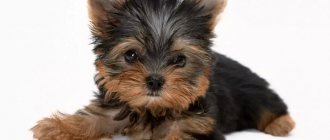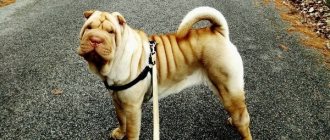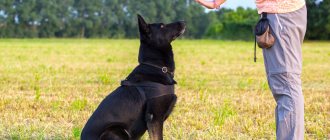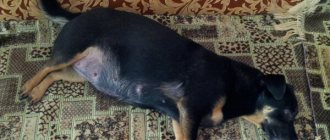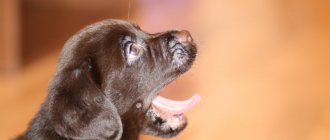The Jack Russell Terrier is a hunting dog with a highly developed instinct of pursuit and is also distinguished by its stubbornness.
Yes, he can be sweet and affectionate with his owner and his family.
But this does not mean that the Jack Russell does not need to be taught commands.
Rather, on the contrary - only timely and correct training of the pet will prevent many problems associated with the breed characteristics of these terriers.
Are they trainable?
By nature, Jack Russells are very intelligent and quick-witted. Training them is not difficult if, when training a dog, you take into account its breed characteristics.
One of the main problems that arise when training Jack Russells is their irrepressible activity, due to which the dog is constantly distracted and cannot normally perceive the trainer’s commands..
In order for your pet to be attentive and focused during classes, it is very important to interest him in the learning process itself. For example, stimulating good work with a game or treat.
Tips from a dog handler
At first, when feeding the puppy, hold the bowl in your hands - he must understand that all the benefits come from you.
Stop all attempts to dominate. Don't let your dog eat from your table, sleep in his owner's bed, or put his paws on you. The dog must obediently give up his things. If he resists, take the toy and, without reacting to aggression, press the dog to the floor with both hands - by the head and croup. Do not let your puppy play with human things, even old ones, as it will be difficult to wean him off this habit, and the dog does not understand the difference between old and new.
At what age should you start?
It is recommended to begin systematic training when the Jack Russell Terrier puppy is two months old.
But by this time he should already know some of the basic commands, since the puppy begins to teach them from the first day of his appearance in the house.
Teaching methods
Professional trainers know at least a dozen training options for each individual skill. The average owner does not need such in-depth knowledge; it is enough to consider the most popular and effective ways of teaching a dog the “down” . The methods listed below are suitable for pets of any age, breed and psychological state.
When choosing any training method, for any dog, the end of the exercise is indicated by a word (most often “walk”). Those. It is not the dog who decides when to get up, but the owner. This will help in subsequent training when practicing endurance.
Pointing method
The most common and simplest method of teaching the “down” command. Equally suitable for the smallest puppies and older dogs. It does not cause discomfort to the animal, when repeated regularly it gives good results and helps to establish contact with the owner.
Training program:
- Starting position – the dog sits in front of the trainer;
- The trainer has motivation in his hand (a piece of treat or a favorite toy);
- A fist with a motivational object is brought to the pet’s very nose, wait until the dog is interested in the thing in the hand;
- Slowly, move the hand with the treat down from the dog’s nose and slightly away from it;
- When it is already clear that the dog is about to lie down, they give the command “lie down”;
- After performance, they give motivation - a treat or a toy;
- Finish the exercise with the command “walk”.
It is very important that the dog receives the reward while lying down, otherwise it is not the execution of the order that is reinforced, but the cessation of the desired action. To increase food motivation, training is carried out with a hungry dog - before meals, or one feeding is skipped.
If a game is chosen as a motivation and the owner throws a ball as a reward, then after laying down, the pet is praised with stroking and affectionate words. And the fetch object is thrown after the command “walk”.
Method of coercion
The coercion method is not suitable for timid, unconfident dogs, and is also not recommended for very small puppies. The method is based on forcibly forcing the animal into a lying position. You can use any variation of the effect:
- Using a leash attached to the collar . They simply pull the leash down, causing the dog discomfort, which can only be avoided by lying down.
- A variation of “sculpting” if the pet does not resist . The dog is laid down using the hands (from a sitting position, taken by the paws and brought to a horizontal position).
- Press firmly on the withers when the dog is sitting . Painful sensations will force the animal to lie down.
A direct order is given only when it is clear that the pet will lie down in any case. The reward in this case is the absence of unpleasant and painful sensations.
It is very important to maintain a reasonable amount of force so as not to injure or intimidate the dog . Otherwise, the predator, at the level of the instinct of self-preservation, may go into a defensive position or begin to run away (depending on the characteristics of the psyche or breed).
Behavior selection method
A very simple method, but it is used quite rarely, because when using it, the owner will have to be patient. Suitable for all breeds and ages, but training takes a long time.
The essence of the behavior selection method is simple:
- The owner “catch” moments when the dog is in a horizontal position;
- Gives the command “lie down” ;
- Encourages in any convenient way.
This training system is suitable for poorly motivated or very restless animals that find it difficult to concentrate on the instructor.
Way to imitate
The imitation method is used in group classes, in the presence of an adult trained individual. Great for young dogs up to one year old.
The essence of the training system is based on competition . The instructor gives the command to the trained pet to “lie down”; after completing the task, the adult dog is actively praised and treated with a treat. At this moment the puppy is in a free position; as a rule, the desire to also get a piece of “yummy” motivates the young animal to repeat the action after its older relative.
Some puppies first try to simply take the treat; all unnecessary actions are simply ignored. It is only necessary to ensure that the adult dog does not bite the small one if he tries to take the food by force.
Where to start education
First, the baby must get used to his nickname, place, and also learn not to get dirty anywhere.
Around the same time, the socialization of the pet begins: the puppy must learn to treat strangers and other animals calmly.
If there are other pets in the house besides the Jack Russell, then the puppy needs to be introduced to them. At the same time, it is very important that a meeting, for example, with a cat, does not leave unpleasant memories for the child.
If the puppy has already had all the vaccinations and passed the quarantine, then you can begin to accustom him to walks on the street, if not, then carry the pet in your arms into the yard so that the baby gets used to street noise, cars and strangers.
It is in the first days after a dog appears in the house that the foundations of its relationship with the owner and members of his family are laid.
It is very important at this time to correctly place the hierarchy in the family, and it is necessary that the puppy occupy the last step in it.
Expert opinion
Kozhevin Semyon Kirillovich
Expert dog handler.
“Of the training methods, the most suitable for the Jack Russell is the so-called “carrot and stick method,” when reward alternates with punishment. At the same time, the dog must deserve both. If he doesn’t obey his owner, if he doesn’t follow a command, he’s punished, but if he does everything right, he’s praised and given a treat. None of the pet’s actions, positive or negative, should go unnoticed, but both reward and punishment should be commensurate with the scale of his action.”
Basics of raising and caring for puppies
Before you bring your Jack Russell Terrier puppy home, be sure to prepare the room: remove wires, unnecessary items, jars of harmful chemicals, and a trash can. Especially try to hide personal belongings, clothes, shoes - Jack Russell Terriers love to chew on everything. Seal all dangerous gaps under sofas, cabinets, etc.
Place for a puppy
After all the necessary manipulations, prepare a place for the baby. Choose a corner for your pet where you will not disturb each other. There should be no heating devices, windows or drafts nearby.
For an active Jack Russell Terrier puppy, you can have a playpen, crate or enclosure so that you can isolate the baby from time to time. Especially if you have to leave him alone. Be sure to put a comfortable and soft mattress there with a pillowcase on it. Change pillowcases when they get dirty.
Jack Russell Terrier puppies are naturally very smart, so raising them correctly will require patience and time. From the first days, let your pet know who is the owner - immediately show him a place to rest to mark his territory. At first, he should stay in the playpen for as long as possible to get used to it.
If you immediately allow your pet to walk wherever he pleases, then in the future it will be extremely difficult to wean him from running around the entire apartment. An inquisitive baby without proper upbringing will always climb into your things, beds and closets, unless you immediately prohibit this. Don't miss the moment - you need to raise a Jack Russell Terrier puppy from the first days, while he is obedient.
Essential Toys
Since “Russells” wake up very early, from inactivity they begin to chew on everything. Therefore, there should always be toys on the pet’s personal territory that will take a hit. It is best to purchase toys made of latex, without plastic or metal parts.
Toilet training
After you have shown your pet where his place is, you need to toilet train him. Usually puppies relieve themselves naturally after sleeping and feeding. In this case, take the baby to the wrong place, where you should put a special diaper in advance, which can be purchased at a pet store. The diaper perfectly absorbs liquid and odor. Don't forget to keep an eye on your dog - as soon as he starts spinning in one place, immediately take him to the toilet.
When you can go outside, after the required vaccinations, begin to teach your dog to relieve itself outside its own walls. To do this, at first take with you a soiled diaper with a familiar smell to your baby. Gradually reduce the size of the diaper by tearing off parts of it. Eventually, get rid of it altogether. By this time, with daily walks, the pet will learn to go to the toilet in the right place.
Walking with a puppy
Together with the puppy, the breeder must give you a sick leave certificate, which indicates all the vaccinations given and planned vaccinations in the future. The first vaccination to maintain immunity is given to the puppy in the first month of life. Deworming should be done once every three months. After twenty-one days you need to get a second vaccination against coronavirus. Also treat your pet's fur monthly with special drops against fleas and ticks. For example, Hartz drops will do the job perfectly.
After you have completed all the necessary vaccinations for your Jack Russell Terrier puppy and have undergone the required two-week quarantine, you can begin to go for walks.
The first hikes with your baby should be short - ten minutes a day will be enough. As soon as the puppy gets stronger, begin to increase the time of walks, based on the physical condition of the pet.
Different weather conditions should not be an obstacle to walking. If it’s raining outside, then take the Jack Russell Terrier puppy out to relieve itself. But make sure that the baby does not get too wet - for this purpose, you can put on special dog clothes.
If it's frosty outside, also go out for a walk with your pet. The walk should be accompanied by active movements. Play outdoor games with your baby - Jack Russell Terriers simply love to frolic in the open air, wallow in the snow and dig holes. Carefully monitor the puppy's condition - if he begins to tremble, tuck his paws, or stops playing, then most likely the baby is cold. In this case, hurry home.
During very hot times of the year, also go for short walks, but do not let your puppy run in direct sunlight for a long time, otherwise he may overheat. Choose shaded places and always let your baby rest if he suddenly lies down in the shade.
Daily walks are necessary for the timely adaptation of the Jack Russell Terrier puppy to the outside world. Otherwise, due to the lack of proper walks, the dog will grow up to be a cowardly dog who will feel uncomfortable in public places.
During the first trips, immediately stop all attempts by your pet to run after cats and yard dogs. Also, do not allow him to pick up dirty objects from the ground. A collar and leash are perfect for this purpose.
Puppy coat care
You should brush your Jack Russell Terrier puppy's coat two to three times a week, regardless of hair type. During seasonal shedding, you will have to brush your dog daily. But dogs with long hair need to visit grooming salons. Although you can cut your baby’s hair yourself, you just need to purchase special scissors and a comb.
From the first days, teach your dog to stand while brushing. Firstly, it is convenient when caring not only for the fur, but also for the rest of the pet’s body. Secondly, if you are going to go to grooming salons for professional grooming or participate in exhibitions in the future, your pet must learn to stand calmly on the table.
Caring for the rest of your puppy's body
Caring for your Jack Russell Terrier puppy's ears involves weekly cleaning. Cotton swabs soaked in chamomile infusion are suitable for this purpose. Once the swab is clean, you need to wipe the puppy's ears with a dry swab.
Rinse your puppy's eyes with warm water from time to time.
Trim the nails as they grow with a special nail clipper.
A puppy's baby teeth do not need special care; it is enough to give him a bone and cartilage for prevention. After seven months, when the dog has replaced its milk teeth with permanent ones, you need to brush them with a special brush and toothpaste, which can be purchased at a pet store.
Bathing a puppy
The first water procedures can be carried out only after scheduled vaccinations two weeks later.
You shouldn’t bathe your Jack Russell Terrier puppy too often with special shampoos - you can damage your pet’s skin. Three times a year is enough. Of course, if your pet is very dirty after walking, you can take a warm shower, but without using shampoo. In general, after walks, wipe your puppy’s paws with a damp cloth.
Feeding the puppy
For the first two to three weeks, feed your Jack Russell Terrier puppy the food recommended by the breeder. Your pet should be switched to other food or natural food gradually.
The puppy should eat from bowls on a stand, the height of which must be adjusted as the dog develops.
From the very first days, teach your Jack Russell Terrier puppy to eat what is given and never feed him from your table. From a very early age, teach your pet to a routine - there is a place and time for eating.
If you decide to feed your puppy natural products, then the diet must include raw lean meat, boiled meat, boneless fish, eggs, cereals, and vegetables. Also add mineral supplements and vitamins. Never give your baby sweet, salty, fried, fatty, smoked, or pickled foods.
Remember that your Jack Russell Terrier puppy's food should be at room temperature.
How to get used to a diaper
In order for your pet to do its business in a certain place, it needs to be accustomed to a diaper.
It's done like this:
- A diaper is placed near the pet's bed, on which the owner places him every time after sleep and after eating. You need to hold him there, wait until the puppy does his business there, and then praise him.
- When the baby understands what a diaper is for, he will begin to wear it himself. After this, you can try to gradually move the diaper to its permanent place. To do this, you need to try to move it 20-50 cm from the bed, and treat the place where it lay before with a special agent that eliminates animal odors.
- If the puppy continues to wear the diaper, then after a couple of days you can try moving it a little more. This way, you can move the diaper to where the dog toilet will be.
- If the puppy, after moving the diaper, refuses to walk on it, they return it to its original place and, after waiting a couple of days, try to move it a little again.
The fact that a small puppy is trained to wear a diaper does not mean that there will no longer be puddles and piles on the floor.
A pet may get carried away and not have time to reach the diaper - there is no need to punish him for this.
Where and when to train a dog
Cynological practice shows that dogs are quite amenable to training from the age of 1.5 - 2 months . Accordingly, you can start introducing the first commands to the puppy at this age, provided that the baby has learned his name. Young dogs, during a period of active growth, have an increased appetite, which simplifies training using the reward method.
The first acquaintance with the “lie down” command should begin at home, in a well-known environment where nothing distracts the puppy. The pet should be walked - this makes it easier for him to concentrate on the trainer. You can move into areas with extraneous stimuli only when the dog has mastered the order and clearly understands what they want from him.
Training with an adult dog, as well as with a puppy, begins in a well-known place, and distractions are added gradually.
How to teach a puppy commands
When teaching a puppy to commands, it is recommended to follow the following rules::
- Training sessions must be systematic.
- The learning process should bring joy to both the pet and its owner.
- You need to study commands according to the principle “from simple to complex.”
- Without accustoming the puppy to one command, you cannot move on to a new one.
- If your pet is tired, you need to give him a rest.
- Punishment should not be too severe, and encouragement should not be excessive.
- It is best to conduct classes in a closed area so that nothing distracts the puppy from the learning process.
CAREFULLY!
It is unacceptable to hit or yell at your pet.
Such “education” will turn the dog away from activities for a long time and will embitter it against the owner.
Jack Russell Terrier training. Command training
A Jack Russell Terrier puppy must be consistently taught the following commands:
- First, they are taught to use the “Place” command.
- As soon as the dog gets comfortable in its new home, you can teach it the “No” or “Fu” command. The puppy begins to assimilate a new command well at 8-10 weeks.
- This is followed by the command “Come to me” or “Come here”, which is mastered during walks at 3-4 months.
- By 6 months, you can begin to teach the accompanying commands “Sit”, “Lie down”, “Quiet”.
The remaining commands, which are not considered very important, should be learned only after the animal has mastered the most important instructions necessary for its daily control and education.
Up to 6 months, you should not overload your puppy with grueling training - 5-10 minutes a day with 2-3 approaches at different times of the day is enough. If the animal becomes sleepy and tries to rest, do not force training on it.
How to train an adult dog to behave outdoors
If a dog lunges at passers-by and other people's dogs, chases cats or pigeons, and also runs after cars and bicycles, you need to call the pet to you, fasten the leash and scold him.
After this, it is recommended to distract the dog by playing or following a few simple commands. If this does not help and the Jack Russell, despite the punishment, continues to pursue the “object” of the hunt, then you need to take the dog to another place.
It is better not to let your dog off the leash at all on city streets, as well as outside the city near busy highways.
What can the stimulus word “Fu” be used for?
Using this command, you can explain to the dog what is acceptable and inappropriate behavior. The punishment can be the fact that you do not give the pet a treat, the tone with which you say “Ugh”, “No”. This is a prohibition command that can also be used on the street. Training a Russell for a walk begins with teaching him to follow along on a leash. It may take a little longer for a dog to understand the rule of not straying far from its owner, compared to calmer and more reserved breeds. Everything is determined by the character of the dog and how successfully mutual understanding is built.
Basic Commands
Nickname
They begin to accustom a Jack Russell puppy to it immediately after purchase.
When choosing a nickname
for a puppy, you need to remember that it should be sonorous and short: no more than two syllables .
"Ugh!"
This command means an order not to pick up anything from the ground or to immediately spit out what the pet has already grabbed in its mouth.
In order to teach it to a puppy, you need to take the object from his mouth and command “Ugh!” in a stern voice.
NOTE!
It’s not always possible to keep track of a dog, so to make your pet safer, it’s also better to play it safe and buy a muzzle. Read how to choose such an accessory here.
"It is forbidden!"
A prohibitory command means an order to stop some unwanted action.
It is taught in the same way as the command “Fu!”: first the command is given in a stern voice, and after a few seconds there is a sharp jerk with the leash.
"Place!"
You need to take the puppy to a rug or bed after he falls asleep on the floor or on the sofa and, after petting him, say: “Place!”
If the Jack Russell tries to leave, you need to hold him in place and repeat the command more strictly.
"To me!"
The owner shows the puppy a treat and commands: “Come to me!” After the pet runs up, reward it with praise and treats.
"Sit!"
The treat is not raised too high above the dog’s head and the command “Sit!” is pronounced. Trying to get it, the puppy will sit down.
"Lie!"
The treat is shown to the pet, after which it is lowered down and slightly forward. Wanting to get it, the puppy will lie down.
"Near"!
The command “Near!” is pronounced, after which the leash is pulled up so that the pet’s withers are near the owner’s left leg.
If the dog tries to run forward or to the side, then the command is given in a more stern voice, and if this does not help, a harsher jerk with the leash follows.
The first classes to teach a puppy basic commands are best done at home..
Weaning off unnecessary barking and biting
An important role in raising a dog is played not only by teaching useful skills, but also by correcting character flaws. It is necessary to wean your Jack Russell Terrier from bad habits such as barking and biting for no reason.
Your puppy may bite and chew on things while he is teething. If a dog bites its owner, you need to take its jaw in your hands and scold it a little, say “you can’t.” Then, during feeding, the bowl is held in front of the pet's muzzle so that it can see the owner's hands. The dog will understand that these hands feed it, which means it cannot bite them.
The Jack Russell Terrier has a hard time with loneliness. When left alone in an apartment, he may bark and whine loudly. Before leaving home, you need to take the dog for a long walk so that it sleeps. It is advisable to turn on the radio so that human voices can be heard in the apartment. The pet is given toys, food in a bowl, and treats. When returning home, you should not immediately pet the dog.
Note! If these measures do not help, many owners ask neighbors or friends to sit with their pets or hire a dog sitter who will walk the dog and sit with it while the owners are not at home.
In addition, the Jack Russell Terrier should not be allowed to put its paws on the lying owner, otherwise the dog will feel like the leader in the family and will stop obeying.
To prevent your dog from chewing things, you need to train it and give it toys to sharpen its teeth on.
How to stop biting?
From the very first day a puppy appears in the house, you need to stop all its attempts to bite its owner.
You cannot provoke or tease a dog . It’s better to completely exclude all games in which the dog grabs the owner’s hands or feet.
If the puppy, having played out, bites the owner, then you can simply switch his attention to another game, for example, give the pet his favorite ball so that he runs after it.
If the aggression was intentional, you need to act differently:
- Ignore. The owner stops playing, goes into another room and does not pay attention to the puppy for 15-20 minutes. Thus, the dog is unambiguously given to understand that no one will play with such an aggressor.
- If a Jack Russell bites and growls, the owner can grab it by the muzzle and hold it there until the dog stops growling.
- An adult terrier can be grabbed by the scruff of the neck and pressed to the floor until he lies down completely. The dog should not be allowed to rise until the owner himself releases it.
- For bites, you can lift the dog by the collar and shake it slightly.
All forceful methods of weaning off aggression must be used with caution so as not to harm or frighten the pet.
Accustoming to equipment at home
Before the first walk, the puppy must be accustomed to a collar and leash. This will take several days and the owner's patience. A leash is an important attribute of a dog owner. It serves as a means of control and as a means of conveying information to the dog.
The puppy is first introduced to the leash. First, he is shown an object, but at the same time his attention is concentrated on a treat or game. Sometimes the ammunition is simply placed near the bedding or bowl for a while. Thus, the pet understands that the leash does not pose a serious danger.
Next, carefully fasten the collar on the pet. In most cases, the puppy's reaction is expressed by complete disobedience and attempts to get rid of the foreign object. To prevent this from happening, he is distracted with a toy or treat.
If the pet responds adequately to the collar and leash, it is left fastened for some time, but with the possibility of freedom of action. The first time, the equipment is left on the puppy for a few minutes. Every day this time gradually increases.
At home, it is recommended to walk around with your pet on a leash a little so that he begins to get used to the fact that his actions are controlled. He is not given complete freedom. On the first walk, the principle is the same - control of the pet without concessions. Any wrong action can lead to the development of destructive behavior and disobedience on the street.
What to do if things get damaged?
As a rule, all “destruction” and damage to things occurs during the absence of the owner.
How to prevent such sabotage from a four-legged animal?:
- When leaving for work, the owner must leave enough toys for his pet.
- You can leave your pet some “long-lasting” treat before leaving, for example, large beef cartilage, but in no case bones.
- You cannot give old slippers or boots to a Jack Russell to be torn to pieces: the dog will not be able to distinguish old from new and next time he will tear to pieces new shoes.
- If the dog chews furniture or walls, they can be treated with special products that have an unpleasant smell and taste for the pet.
IMPORTANT!
You should not leave your pet alone for a long time without first walking it and feeding it.
The inability to release energy and hunger will only strengthen the animal’s desire for destruction.
Jack Russells are friendly and obedient dogs that are easy to train..
They easily and willingly learn new commands and carry them out with pleasure. Problems can arise when there is no trusting relationship between the pet and its owner.
To prevent this from happening, the owner must devote enough time to his pet from the very beginning, be strict but fair towards him.
Only in this case will the Jack Russell recognize him as his master, whom he will obey impeccably and whose commands he will carry out.
Common mistakes at home
Mistakes are usually made by inexperienced owners. Any dog needs to be trained, regardless of breed and size. Mistakes make it difficult to work with your pet and can lead to unwanted reflexes. All erroneous actions are based on a misunderstanding of dog behavior and a lack of basic training skills.
The biggest mistake is to evaluate a pet’s behavior as human. This is fraught with the fact that during training the dog begins to receive demands that it cannot fulfill. Accordingly, if this is not done, the owner uses physical violence, which develops fear of humans in the pet.
Excessive physical and mental stress leads to nervousness and fatigue in the dog. A tired pet stops following commands and generally responding to them. Therefore, the owner must draw up a training program in advance and include regular breaks in it.
